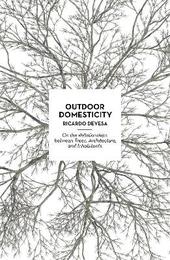
|
Outdoor Domesticity: Houses and Trees
Paperback / softback
Main Details
| Title |
Outdoor Domesticity: Houses and Trees
|
| Authors and Contributors |
By (author) Ricardo Devesa
|
| Physical Properties |
| Format:Paperback / softback | | Pages:240 | | Dimensions(mm): Height 234,Width 134 |
|
| Category/Genre | Architectural structure and design |
|---|
| ISBN/Barcode |
9781948765718
|
| Classifications | Dewey:720.47 |
|---|
| Audience | |
|---|
|
Publishing Details |
| Publisher |
Actar Publishers
|
| Imprint |
Actar Publishers
|
| Publication Date |
10 February 2022 |
| Publication Country |
United States
|
Description
Trees have been deliberately connected with houses since they were introduced as a prominent part of architectural design. The relationships of contiguity between houses and trees have existed since ancient times. However, at the end of the 19th century those links became explicit in the design process, as the house emerged as one of the fundamental architectural programs, and as the result of an increasing sensibility towards environmental aspects and the landscape. The first part of this publication is to present a collection of exemplary five houses that evinced explicit relationships with pre-existing trees. The five twentieth century projects are: La Casa (B. Rudofsky, 1969), Cottage Caesar (M. Breuer, 1951), Ville La Roche (Le Corbusier & P. Jeanneret, 1923), Villa Pepa (J. Navarro Baldeweg, 1994) and Hexenhaus (A. & P. Smithson, 1984-2002). The second part of the book contributes three theoretical concerns for the contemporary project, those ones which are established in the process, with respect to time, place and outdoor domesticity in modern western housing. One of these theoretical contributions establishes that any house located on a site finds a significant place in conjunction with the preexisting trees. The second contribution describes the effects in terms of time, in addition to spatial considerations, which trees can contribute to the architectural project. Finally, the establishment of these connections between architecture and trees enlarges the idea of the house: the tree serves to draw the surrounding environment into the house and, as a result, becomes an intrinsic part of the house itself.
Author Biography
Ricardo Devesa received his degree in architecture from the Valencia School of Architecture and he holds a PhD from Barcelona Tech University (UPC, 2012) for his dissertation Houses & Trees (to be published in 2020). He is currently editor-in-chief at Actar Publishers, and at his digital platform urbanNext.net, based in Barcelona and New York. Since 2019 he is professor of architectural design at the School of Architecture La Salle, University Ramon Llull (ETSALS), as well as the coordinator of its Master in Integrated Architectural Design. He was associate professor of Architecture Theory and History at the Barcelona School of Architecture of Barcelona (ETSAB, UPC, 2011-2016) and senior professor at the Institute for Advanced Architecture of Catalonia (IaaC, 2013-2019). He served as a member of the editorial staff of the magazine Quaderns d'Arquitectura i Urbanisme (1997-1999) and was a member of the editorial board for the magazine Basa (2004-2008). He was a visiting scholar at Graduate School of Architecture (GSAPP) Columbia University in New York (2007-2009). He is coauthor of Otra mirada. Posiciones contra cronicas. La accion critica como reactivo en la arquitectura espanola reciente (Gustavo Gili, 2010) and Barcelona: Modern Architecture Guide (Actar, 2013) as well as editor in many books published by Actar since 2012.
Reviews"Summer is the season when people tend to spend the most time outdoors, so a book devoted to the relationship between trees and buildings is fitting for inclusion in a summer reading list. Ricardo Devesa, editor in chief at Actar, has adapted his ten-year-old doctoral dissertation for this compact, heavily illustrated book that analyzes five houses whose architects incorporated pre-existing trees into their designs: Bernard Rudofsky's La Casa (Frigiliana, Spain, 1972); Marcel Breuer's Caesar Cottage (Lakeville, CT, USA, 1952); Le Corbusier and Pierre Jeanneret's Villa La Roche (Paris, 1923); Juan Navarro Baldeweg's Villa Pepa (Spain, 1993); and Alison and Peter Smithson's Hexenhaus (Bad Karlshafen, Germany, 1984-2002).... --15 Summer Reads, World-Architects
|